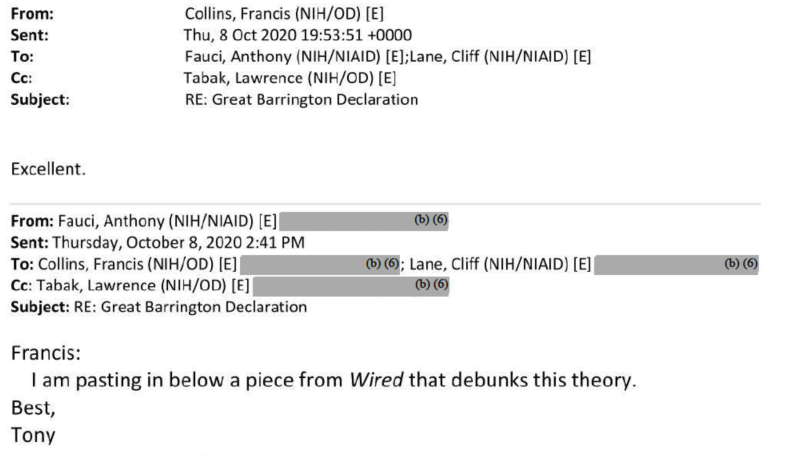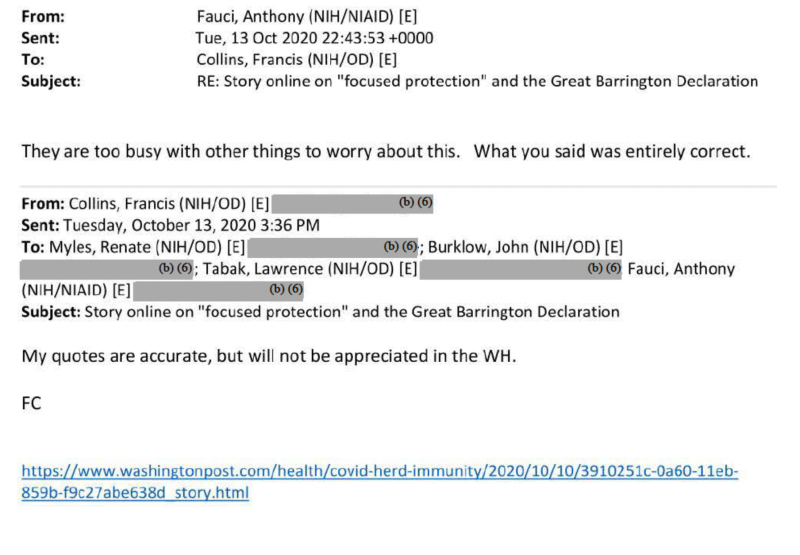Yes, there were some attempts to sabotage it too, with fake names and so on, which should have been a clue about what was coming. The fakes were deleted in days and new methods of confirming signatures were deployed.
The document, on the one hand, said nothing controversial. The right way to deal with this pandemic, it said, was to focus on those who could face severe outcomes from disease – a very plain point and nothing new. There was nothing to be gained by locking down the whole of society because of a pathogen with such a huge differential in its demographic impact.
The virus would have to become endemic in any case (including the realization of “herd immunity,” which is not a “strategy” but a descriptive term widely accepted in epidemiology) and certainly would not be stopped by destroying peoples’ lives and liberties.
The hope of the Declaration was simply that journalists would pay attention to a different point of view and a debate would begin on the unprecedented experiment in lockdowns. Perhaps science could prevail, even in this climate.
On the bad side, and at the very same time, following the release, the attacks began pouring in, and they were brutal, structured to destroy. The three main signers – Sunetra Gupta (Oxford), Martin Kulldorff (Harvard), and Jay Bhattacharya (Stanford) – made the statement as a matter of principle. It was also born of frustration with the prevailing narrative.
Mostly this declaration was intended as an educational effort. But the authors were being called vicious names and treated like heretics that should be burned. There certainly was no civil debate; quite the contrary.
It was all quite shocking given that the Declaration was a statement concerning what almost everyone in these professional circles believed earlier in the year. They were merely stating the consensus based on science and experience. Nothing more. Even on March 2, 2020, 850 scientists signed a letter to the White House warning against lockdowns, closures, and travel restrictions. It was sponsored by Yale University. Today it reads nearly like a first draft of the Great Barrington Declaration. Indeed on that same day, Fauci wrote to a Washington Post reporter: “The epidemic will gradually decline and stop on its own without a vaccine.”
But following the March 13-16, 2020 lockdowns, the orthodoxy had evidently changed. And suddenly. The signers of the GBD had declined to change with it. Thus did they endure astonishingly brutal smears. What felt odd at the time was the sheer intensity of the attacks, as well as their dogmatism and ferocity. These attacks also had a strong political flavor that had little regard for science.
Already by the summer, it was very clear that the lockdowns had not achieved what they were supposed to achieve. Two weeks had stretched into many months, and the data on cases and deaths were uncorrelated with the “mitigation measures” that had been imposed on the country and the world. Meanwhile, millions had missed cancer screenings, schools and churches had been shut, public health was in a state of crisis, and small businesses and communities were fighting to stay alive.
It was obvious on October 4, 2020, when the Declaration was released, that it was a correct statement and that the lockdowns had failed by every measure. Following Trump’s fatal March 2020 decision to acquiesce to Anthony Fauci and Deborah Birx, the president had pushed for reopening the country and treating this pathogen as a disease with normal medical methods. He was not making much headway, however. The handful of people around Trump who had been responsible for pushing them were digging in, prepared to wage a full war on dissent.
What historian Phil Magness has discovered, with newly unearthed emails, comes not as a shock to any of us but it is satisfying to see the confirmation of what we suspected. It seemed at the time that the effort to attack and destroy both the GBD and its authors was coordinated from the top. Here at last is the proof that our intuition was not crazy.
The author of the initial email is Francis Collins, director of the National Institutes of Health. The recipients were Anthony Fauci and H. Clifford Lane, NIAID Deputy Director for Clinical Research and Special Projects.The email calls for a “published take down” of the GBD that is both “quick and devastating.”

That evening, Fauci wrote back, not with a reference to any scientific papers supporting lockdowns and so on but with a piece from the gadget publication called Wired, which said the GBD is wrong because “quite literally arguing with the past” because the lockdowns are no longer being used. Collins responded: “excellent.”

The next day, Fauci struck again with an article from the pro-lockdown leftist newspaper The Nation. It’s a demoralizing reference simply because the public was led to believe that between his endless TV interviews, Fauci was scouring “the science” to find out more about SARS-CoV-2, not googling and landing on highly politicized and ideological webzines. What we find in these emails are highly political people who are obsessed not with science but with messaging and popular influences on the public mind.

Days later, Collins himself gave quotes to the Washington Post that ridiculed the position that society should reopen. He was clearly attacking Trump and the White House generally. Fauci said not to worry about it because they were too busy with other things, e.g. the election.

Over the following weeks, many new pieces appeared in the popular press. These gentlemen eagerly shared them.
What do we learn from these emails? The attacks on tens of thousands of medical professionals and scientists were indeed encouraged from the top. The basis for the attacks were not scientific articles. They were heavily political popular pieces. This adds serious weight to the impression we all had at the time, which was that this was not really about science but about something far more insidious.
You can discover more about this in Scott Atlas’s book on the topic. These new emails confirm his account. It was an outright war on top scientists, people whose views on matters of public health were not different from the professional consensus only earlier in the year. For that matter, Anthony Fauci himself warned against lockdowns in January and February, favoring instead normal methods of mitigation.
My own estimate is that the convinced advocates of lockdowns when they took place were probably fewer than 50 in the US. How and why they managed to grab hold of the reins of power will be investigated by historians for many decades. The incredibly positive response to the Great Barrington Declaration, which has garnered 900,000 signatures in the meantime, demonstrates that there was and is still life remaining in traditional public health measures deployed throughout the 20th century and still respect for human dignity and science remaining among medical professionals and the general public.
Please remember that Anthony Fauci and Francis Collins are not just two scientists among hundreds of thousands. As the NIH site says, it “invests about $41.7 billion annually in medical research for the American people.” With that kind of spending power, you can wield a great deal of influence, even to the point of crushing dissent, however rooted in serious science the target might be. It might be enough power and influence to achieve the seemingly impossible, such as conducting a despotic experiment without precedent, under the cover of virus control, in overturning law, tradition, rights, and liberties hard won from hundreds of years of human experience.
This war on dissent against lockdowns is not only a scandal of our times. The lockdowns and now the mandates have fundamentally transformed society and its relationship to government, technology, media, and much more. The emergency continues. Protests have arisen the world over but they are hardly even covered by the media. We seem ever more to be on the precipice of total disaster, one that will be difficult to reverse. It is urgent that we know who did this, as well as how and why, and take steps to stop it before more damage is done and then becomes permanent.
 RSS Feed
RSS Feed















 December 21st, 2021
December 21st, 2021  Awake Goy
Awake Goy  Posted in
Posted in  Tags:
Tags: 













